CBW-01 Introduction
Table of Contents
- Content is generally described as any type of text, graphic, image, video, form, or any other interactive element on the website, web page, or post.
- Content has a central importance in any website.
- The nature of content depends on the type of business. Retail sites feature a catalogue of products. University sites contain information about their campuses, curriculum, and faculty. News sites show the latest news stories.
- A blogger should update the content regularly. You might have a bunch of observations or reviews for a personal blog. Without updated content, there is little reason to visit a website more than once.
- Some blogs have a single author, and some have multiple authors. Each author writes his/her own articles. Typically, blog authors compose their articles in a web-based interface built into the blogging system.
- Some blogging systems also support using stand-alone “weblog client” software, allowing authors to write articles offline and upload them later.
What is Blog
- A “blog” is an updated version of the old term “weblog,” used to describe websites that maintain an ongoing chronicle of information.
- A blog features diary-type commentary and links to articles on other websites, usually presented as a list of entries in reverse chronological order.
- Blogs range from personal to political and can focus on one narrow subject or a whole range of subjects.
- Many blogs focus on web design, home staging, sports, mobile technology, etc.
- Few are more eclectic, presenting links to all types of other sites. And others are more like personal journals, presenting the author’s daily life and thoughts.
Importance of Quality Content in Digital Marketing
Good Content Promotes SEO
- When it comes to digital marketing, SEO has its own recognition and importance.
- Content Writer must be aware of top SEO practices to rank higher in Google. But, it is never easy to impress the search engines without quality content.
- SEO is all about good placement and linking of keywords in the content. The main purpose of search engines is to fulfil search intent by fulfilling their audience’s desires.
- So, if you are creating extremely helpful content on your website and mobile app it will rank better on the search engine ranking pages.
SMO Depends on Quality Content
- Social Media is now proving as a very strong marketing platform for every type of business.
- SMO through various tools like social media posts, videos, infographics, images, gifts, and quotes, forces social media platforms to promote the pages that produce quality content for their users.
- So, when you are educating your social media audience with good content, you will start to receive huge recognition on these platforms.
- And once you did that, we all know how effective are social media platforms when it comes to digital marketing.
Easy to Connect with Others
- Earning quality links for your business websites and connecting with others in your industry becomes easy when you publish good content.
- In other words, if you are regularly productive helpful content on your website, social media pages, mobile application, and other platforms, people would love to share it and get linked to it.
- In this way, getting quality links never becomes a hassle. In fact, people would connect with your automatically.
- This will eventually boost your SEO and provide you more ways to grow in your domain.
Content Increases Your Brand Authority
- In the field of digital marketing, improving online presence and brand credibility are two highly focused fields.
- But, when you focus on creating good content for your audience, people start to rely upon and believe in you.
- A good content strategy helps the marketing of products & services through different Digital Branding Channels.
- Good Content means content to which the audience can relate themselves and get attracted to it. This automatically helps you to increase your brand recognition.
- A good online reputation would effectively increase your growth rates.
- So, if you are popular among search engines and social media platforms, you are on the right way. But, regular content is important to achieve this goal.
Increased Conversion Rates
- When you have good content on your website or other platforms, it means you have an increased chance of getting a good amount of online traffic.
- Also, traffic will be relevant and highly productive.
- So, now it's your responsibility to educate the audience through good content and make convince them to buy your products and services, and they would definitely buy them.
- Although effective implementation services are required to sell the right product at the right time on the right page.
- However, if we talk broadly, creating good quality content will definitely help you a lot to achieve good conversion rates.
Understanding Target Audience & Defining Objectives
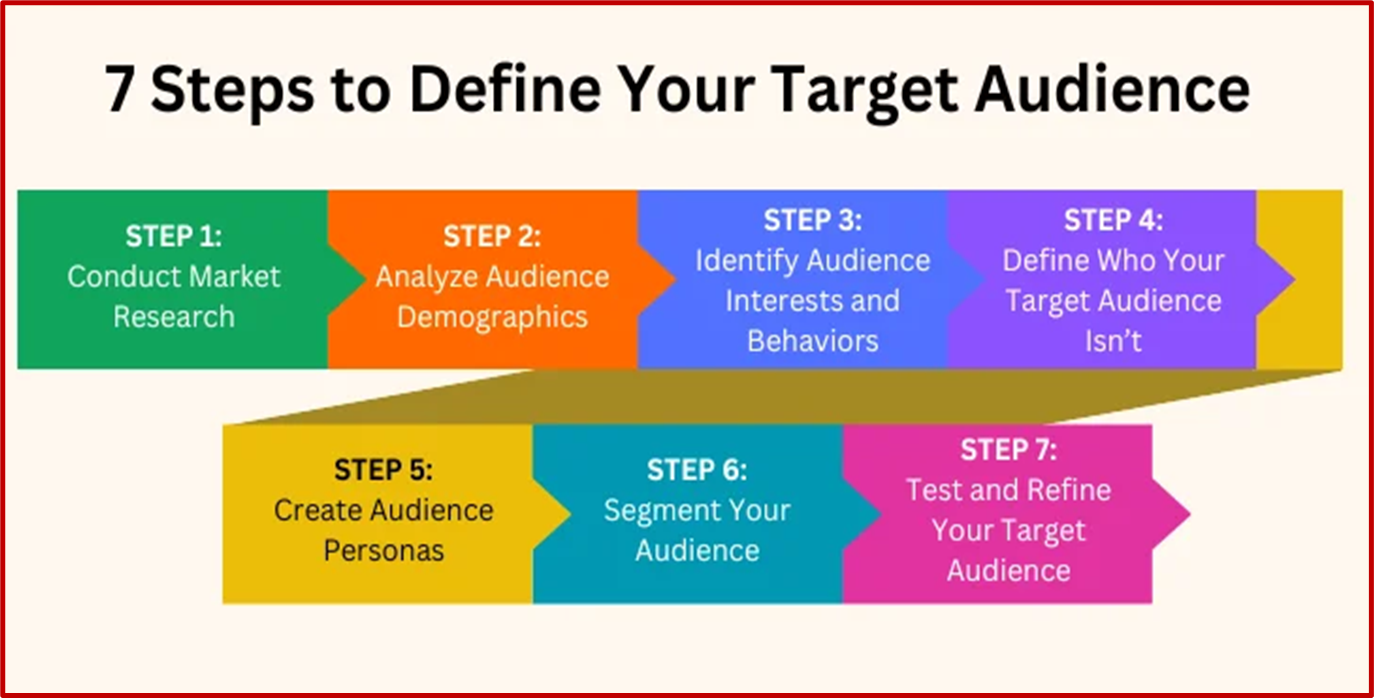
Conduct Market Research

Analyse Audience Demographics
- Look at the demographic data.
- Identify factors like age, gender, income, education, and location.
- This information is crucial in understanding who makes up your target audience.
- Demographics provide a snapshot of who your potential customers are.
- This helps tailor your cold email outreach to the right groups.
Identify Audience Interests and Behaviours
- Find out what interests your audience. Analyse their online behaviour, preferences, and purchase history.
- Knowing their interests helps in crafting messages that resonate.
- This step involves monitoring social media, forums, and review sites. You can use analytics tools to gain insights into what content your audience engages with.
- This helps in understanding their motivations and pain points.
Define Who Your Target Audience Isn’t
- Identify who does not fit your target audience. This helps you eliminate people that are not relevant to your business.
- Focus your efforts on those who are more likely to convert.
- Defining who your audience isn’t helps save resources. It prevents you from wasting time and money on unlikely prospects.
- This step ensures your marketing efforts are more efficient and effective.
Create Audience Personas
- Develop detailed audience personas. These are fictional characters that represent your ideal customers. Include details like their goals, challenges, and preferences.
- Personas help humanize your audience. They make it easier to understand their needs and how your product or service can help.
- This step helps in creating more personalized and relevant marketing messages.
Segment Your Audience
- Divide your audience into segments. Group them based on shared characteristics or behaviours. This allows for more targeted and effective marketing.
- Segmentation helps in addressing specific needs of different groups. It improves engagement and conversion rates.
- Examples of segments include demographics, geographic location, psychographics, and behavioural patterns.
Test and Refine Your Target Audience
- Test your assumptions. Use A/B testing and feedback to refine your understanding. Adjust your strategy based on what you learn to better reach your target audience.
- This step involves continuous monitoring and optimization. It ensures that your marketing efforts stay relevant and effective.
- Testing different approaches helps in finding what works best for your audience.
Types of Target Audiences + Examples
Demographic Target Audience Examples
| Business | Target Audience |
|---|---|
| Luxury car brand | high income professionals |
| Beauty brand | women aged 18-34 |
| Software company | professionals with advanced degrees |
Geographical Target Audience Examples
| Business | Target Audience |
|---|---|
| Local Restaurant | customers with 5-mile radius |
| Winter Apparel Company | cold regions |
| City-based Gym | urban residents |
Psychographic Target Audience Examples
| Business | Target Audience |
|---|---|
| Fitness brand | health-conscious individua |
| Sustainable products company | eco-conscious consum |
| Gaming company | avid ga |
| Luxury brand people who value exclusivity & prestige and |
Behavioural Target Audience Examples
| Business | Target Audience |
|---|---|
| Online retailer | frequent gadget buyers |
| Streaming services | users with premium subscriptions |
| Coffee shop | regular customers with loyalty programs |
Firmographic Target Audience Examples
| Business | Target Audience |
|---|---|
| B2B software company | mid-sized tech firms |
| Financial services firm | banks and insurance companies |
| Marketing agency | small businesses needing branding help |
Common Mistakes to Avoid in Defining Your Target Audience
- Not Aware of your Audience Base
- Headlines Are Not Attractive
- Not Doing Enough Research
- Saying the Same things All over again
- Duplicate Content
- Ignoring SEO
- Bad Grammar
Basics of Storytelling & Narrative Structure
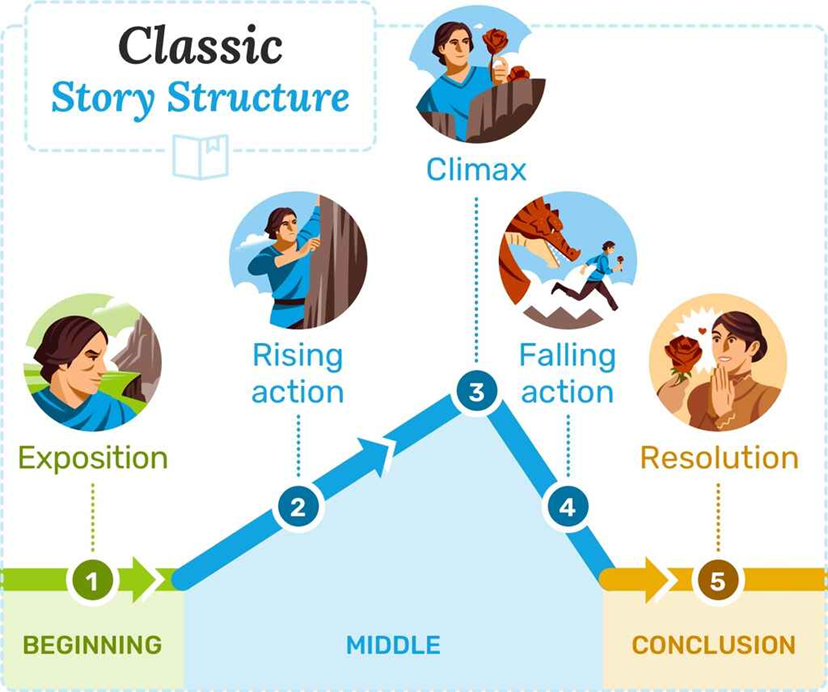
Elements of classic story structure:
- Exposition: This first part establishes a protagonist's normal life and greater desires, and usually culminates in the inciting incident.
- Rising action: The protagonist pursues their new goal and is tested along the way.
- Climax: Our hero achieves their goal — or so they think!
- Falling Action: The hero now must deal with the consequences of achieving their goal.
- Resolution: The conclusion tying together the plot, character arcs, and themes.
Seven Story Structures Every Writer Should Know
Freytag's Pyramid
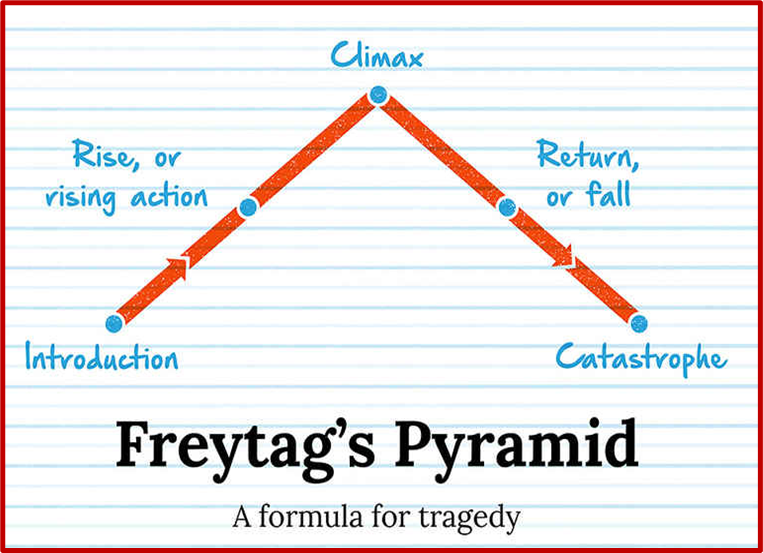
Named after a 19th-century German novelist and playwright, Freytag’s Pyramid is a five-point dramatic structure that’s based on the classical Greek tragedies of Sophocles, Aeschylus, and Euripedes.
- Introduction: The status quo is established; an inciting incident occurs.
- Rise, or Rising Action: The protagonist actively pursues their goal. The stakes heighten.
- Climax: A point of no return, from which the protagonist can no longer go back to the status quo.
- Return, or Fall: In the aftermath of the climax, tension builds, and the story heads inevitably towards...
- Catastrophe: The protagonist is brought to their lowest point. Their greatest fears have come true.
The Hero's Journey
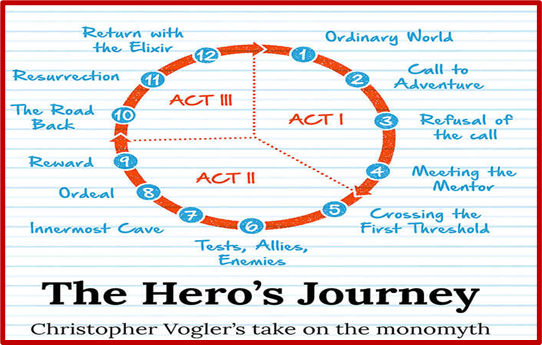
Inspired by Joseph Campbell’s concept of the monomyth — a storytelling pattern that recurs in mythology all over the world — The Hero’s Journey is today’s best-known story structure. Some attribute its popularity to George Lucas, whose Star Wars was heavily influenced by Campbell’s The Hero With a Thousand Faces.
- The Ordinary World: The hero’s everyday life is established.
- The Call of Adventure: Otherwise known as the inciting incident.
- Refusal of the Call: For a moment, the hero is reluctant to take on the challenge.
- Meeting the Mentor: Our hero meets someone who prepares them for what lies ahead — perhaps a parental figure, a teacher, a wizard, or a wise hermit.
- Crossing the First Threshold: The hero steps out of their comfort zone and enters a ‘new world.’
- Tests, Allies, Enemies: Our protagonist faces new challenges — and maybe picks up some new friends. Think of Dorothy on the Yellow Brick Road.
- Approach to the Inmost Cave: The hero gets close to their goal. Luke Skywalker reaches the Death Star.
- The Ordeal: The hero meets (and overcomes) their greatest challenge yet.
- Reward (Seizing the Sword): The hero obtains something important they were after, and victory is in sight.
- The Road Back: The hero realizes that achieving their goal is not the final hurdle. In fact, ‘seizing the sword’ may have made things worse for them.
- Resurrection: The hero faces their final challenge — a climactic test that hinges on everything they’ve learned over their journey.
Three Acts Structure

Following the old adage that “every story has a beginning, middle, and end,” this popular structure splits a story’s components into three distinct acts: Setup, Confrontation, and Resolution. In many ways, the three-act structure reworks The Hero’s Journey, with slightly less exciting labels.
- Act 1: Setup:
- Exposition: The status quo or ‘ordinary world’ is established.
- Inciting Incident: An event that sets the story in motion.
- Plot Point One: The protagonist decides to tackle the challenge head-on. She ‘crosses the threshold,’ and the story is now truly moving.
- Act 2: Confrontation:
- Rising Action: The story's true stakes become clear; our hero grows familiar with her ‘new world’ and has her first encounters with some enemies and allies. (see Tests, Allies, Enemies)
- Midpoint: An event that upends the protagonist’s mission. (Similar to the climax in Freytag’s pyramid)
- Plot Point Two: In the wake of the disorienting midpoint, the protagonist is tested — and fails. Her ability to succeed is now in doubt.
- Act 3: Resolution:
- Pre Climax: The night is darkest before dawn. The protagonist must pull herself together and choose between decisive action and failure.
- Climax: She faces off against her antagonist one last time. Will she prevail?
- Denouement: All loose ends are tied up. The reader discovers the consequences of the climax. A new status quo is established.
The Story Circle
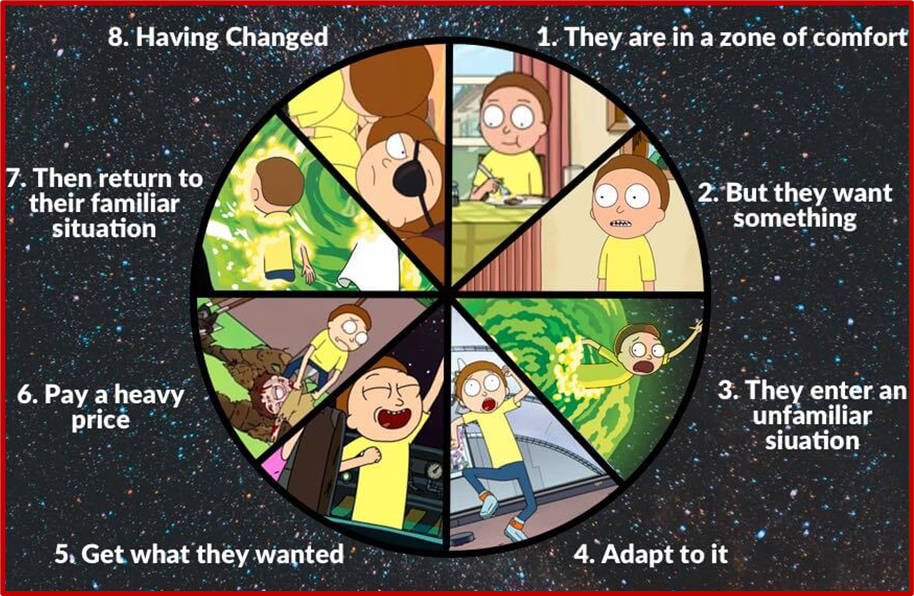
Another variation on Campbell’s monomyth structure, the Story Circle is an approach developed by Rick and Morty co-creator Dan Harmon. Again, heavily inspired by the Hero's Journey, the benefit of Harmon's approach is its focus on the protagonist's character arc. Instead of referring to abstract concepts like 'story midpoint' and 'denouement', each beat in the story circle forces the writer to think about the character's wants and needs.
- A character is in a zone of comfort... This is the establishment of the status quo.
- But they want something... This 'want' could be something long-standing and brought to the fore by an inciting incident.
- They enter an unfamiliar situation... The protagonist must do something new in their pursuit of the thing they want.
- Adapt to it... Faced with some challenges, they struggle then begin to succeed.
- Get what they wanted... Usually a false victory.
- Pay a heavy price for it... They realize that what they 'wanted' wasn't what they 'needed'
- Then return to their familiar situation... armed with a new truth.
- Having changed... For better or worse.
Save the Cat
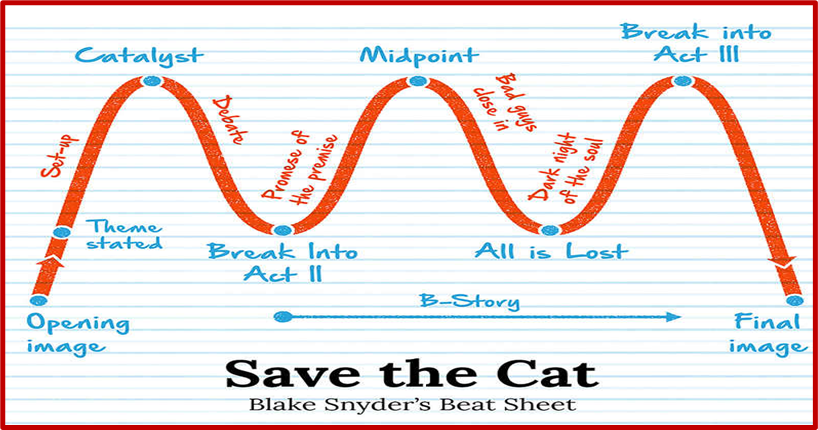
Another variation of the three-act structure, this framework created by Hollywood screenwriter Blake Snyder, has been widely championed by storytellers across many media forms.
- Opening
- Set-up
- Theme Stated
- Catalyst
- Debate
- Break into Two
- B Story
- The Promise of the Premise
- Midpoint
- Bad Guys Close In.
- All is Lost
- Dark Night of the Soul
- Break into
- Finale
- Final
Popular Blogging Platforms.
| Tools | Best For | Key Features |
|---|---|---|
| WordPress | Overall blogging | - User-friendly setup with pre-installed themes - Scalable plans with advanced features - Extensive plugins for customization - SEO and performance optimization options |
| Ghost | Professional writers and publishers | - Hundreds of themes - Minimal, no-code editor - Dynamic cards for rich media - Built-in email marketing setup |
| Squarespace | AI-powered website design | -AI tools for site design and content generation - Monetization tools - Performance analytics - Team collaboration tools |
| Wix | Beginner-level bloggers | - 900+ customizable templates - AI assistant for content generation -Built-in SEO tools |
| Medium | Integrated audience and monetization | - Built-in audience - Monetization through the Partner Program - Performance insights |
Questions
- What is a blog, and how does it differ from other types of content on the web? 2
- Discuss the role of quality content in digital marketing. And Why is importance?
- What is SEO, Why is Important for Blogger And Content Writers?
- What Are Common Mistake to Avoid Target Audience Explain with short details?
- Describe the process of understanding and identifying a target audience.
- Explain the basics of storytelling and narrative structure in content writing. How can writers use these techniques?
- Give an overview of popular blogging platforms With details
- WordPress
- Blogger
- Medium
- Wix